CzechWrecks 2010
CzechWrecks 2010
One evening in October 2009 I was talking on the phone to my friend Steve Pronger when he drew my attention to an article in the Daily Telegraph about the CzechWrecks rally. The event is what is known as a Banger Rally, and is organised by a company called StreetSafari Ltd., (www.streetsafari.com) which runs several such events every year.
CzechWrecks entails buying a car for £150 and driving it to Prague via France, Switzerland, Italy, Austria, and Germany, over a 1500 mile route taking in many of the famous alpine passes. The route is set by the organisers, and is split into four stages of one day each, with various unspecified additional challenges along the way. The car has to be more than 15 years old, and you are allowed to spend as much as necessary on it in the interests of safety. The event is clearly for people who are crazy, which made it ideal for Steve and myself.
It did not take us long to decide to have a go, and in due course I completed the online entry form and sent off the £200 fee into the ether via PayPal. To do this we needed a team name, and as Steve was away I had to think of something quickly. I wrote down a list of possibilities, and decided that the best was "Worn and Torn", although I still do not know whether this referred to the car that we did not yet have or to the occupants thereof.
In due course our entry was confirmed, and when I told Steve he informed me that he had already got a car lined up for £100. It was a 1990 Ford Sierra Sapphire 2-litre that belonged to one of his friends, but had been off the road for some time, had no MOT and needed some work.
In January we received an email from the event organisers to say that they had changed the points system on the event. In previous rallies points were awarded for various 'challenges' carried out during the journey, and some people with really rough old cars had decided not to take part in the challenges because their cars would not stand up to it. A new points system was being introduced to take account of the size, condition and presentation of the car (how it was painted up, etc.). The least suitable cars would now start with a considerable points advantage, i.e. the better cars would be handicapped. We quickly realised that we were going to start with no points at all, but were not bothered because we were there for the hell of it, not to win.
By the end of January Steve had got the car and checked it over. He replaced the front discs and pads, all the fluids and belts, at a total cost of about £400. On 6th February I received an email with one word - "Yippee!", the car had passed its MOT.
Steve then made me book the ferry and hotels. Although he is supposed to be a scout leader he was not keen on camping. Three of the night stops were in Interlaken, Bormio, and Salzburg, which are not by any stretch of the imagination cheap places, but on the internet I managed to find hotels that did not completely break the bank. It was probably worthwhile booking early.
A few weeks before the event, which was to start on 27th August, the car came to stay with me. Steve had already done a few hundred miles in it and everything seemed to work excepting for the air-conditioning, which was not worth repairing. The only thing I found wrong with it was the cigar lighter socket (it was a Ghia, I think the cheaper versions have a cigarette lighter) which we would need for the satnav. Using some bits and pieces I found in my garage I fitted a socket on a flying lead.
 The starting point for the rally was in Calais on the Friday morning, and we had to check in at a bar in the town centre the evening before. On the way to Dover from Steve's house in Uckfield the satnav stopped working, and it turned out that the 30-year old socket I had fitted had fallen to pieces due to corrosion. Steve was not very impressed, but we managed to patch it up while we were waiting for the ferry.
The starting point for the rally was in Calais on the Friday morning, and we had to check in at a bar in the town centre the evening before. On the way to Dover from Steve's house in Uckfield the satnav stopped working, and it turned out that the 30-year old socket I had fitted had fallen to pieces due to corrosion. Steve was not very impressed, but we managed to patch it up while we were waiting for the ferry.
After calling at the Etap Hotel in Calais we drove to the check-in, and on the way I lost the back end slightly on a roundabout, causing Steve to be not very impressed again. At the check-in we had our first sight of the other "competitors" and reported to a rather serious looking young man named Justin who gave us some forms to fill in. His lady assistant was doling out excellent T-shirts and the competition numbers that we supposed to stick on the car, but unfortunately she did not have any numbers for us because I had omitted to order them. Before going to the meeting place on the quayside the next morning we had to make some numbers out of insulating tape.
Day 1. Friday 27th August. Calais to Interlaken, Switzerland. Approx. 550 miles.
The collection of 60 cars on the quayside in Calais was interesting, to say the least. Just a few examples were:
A Citroen 2CV with the body cut down so that it was just wide enough for one person.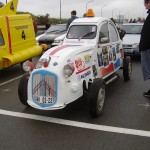
A yellow Renault van with Thunderbirds styling features and music.
A 1966 Triumph Herald in well-used condition.
A Jaguar XJ6 made up in the style of a Lancaster bomber, with Dambusters music.
A Skoda with Golf badges, covered with grass and with a model golf course on the bonnet.
A Volvo containing three Morris dancers and the bonnet laid out as a tea table.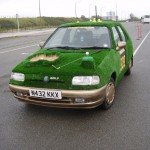
A BMW painted up as a fire engine, with a hydrant connection on the bonnet.
A Daihatsu with a solar cell on the bonnet and wind generator attached to the roof.
A Lexus 400 with a second roof suspended above the original one, in defiance of the organisers' ruling that the roof must not be cut off.
However, looking at the cars, it was difficult to believe that some of them had been bought for £150. Many of the occupants were dressed to match the theme of their vehicles, and it was clear that we had not entered into the spirit of the event to the same extent as some other people. We could not make any serious cosmetic changes to our car because there was already a buyer lined up for it if it survived intact.
After a loud blast on a horn we set off, and as we left the car park we were given details of the first challenge, which was to photograph certain buildings at the former Grand Prix circuit near Reims, which we were expected to reach at about midday. It goes without saying that there was some commotion as 60 cars drove through the town to the autoroute.
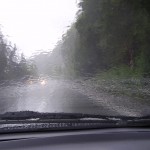 We were allowed to take any route we liked, but the time schedule dictated that we used the autoroute, especially as the weather was bad, with heavy rain. At times it was so bad that it was difficult to see much at all through the spray when overtaking the lorries. By midday we were near the meeting place for the challenge when we took a wrong turning in some road works on the autoroute and finished up going 14 miles to the next exit before we could turn back. Now, I am not going to say whose fault this was, but as team leader I realise that I have no alternative but to accept ultimate responsibility for mistakes made by any member of my team. Anyway, we decided that we had lost so much time that it would be best to miss out the challenge and press on. The same thing actually happened to several other Czechwrecks teams.
We were allowed to take any route we liked, but the time schedule dictated that we used the autoroute, especially as the weather was bad, with heavy rain. At times it was so bad that it was difficult to see much at all through the spray when overtaking the lorries. By midday we were near the meeting place for the challenge when we took a wrong turning in some road works on the autoroute and finished up going 14 miles to the next exit before we could turn back. Now, I am not going to say whose fault this was, but as team leader I realise that I have no alternative but to accept ultimate responsibility for mistakes made by any member of my team. Anyway, we decided that we had lost so much time that it would be best to miss out the challenge and press on. The same thing actually happened to several other Czechwrecks teams.
The weather continued to be bad, and on both sides of the Swiss border we ran into typical Friday evening traffic which was very slow going, but we arrived in Interlaken at 8.15 and went straight to the hotel. This turned out to be very, very, Swiss, and I had a quaint little 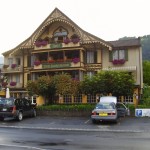 room with a balcony inside a large fretwork structure on the front of the building, so that it was just like being inside a cuckoo clock. Fortunately Steve had a more conventional room, because he would hardly have been able to stand up in mine.
room with a balcony inside a large fretwork structure on the front of the building, so that it was just like being inside a cuckoo clock. Fortunately Steve had a more conventional room, because he would hardly have been able to stand up in mine.
We walked down to the meeting place in the town, and saw a number of other Czechwrecks cars on the way, including the Triumph Herald. On the autoroute we had thought about them, with their 1960s windscreen wipers, and they did extremely well to get to Interlaken in the time, especially considering that they completed the challenge at the Reims circuit. When we reported to the organisers at 9.30 they said only 20 teams had turned up so far. We had covered almost 600 miles in the day.
Day 2. Saturday 28th August. Interlaken to Bormio, Italy.
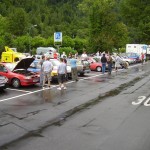 The meeting place was a large car park near the river, and our initial impression was that there were noticeably fewer cars than at Calais. There were stories of people arriving at 1.30am after all sorts of problems, but most teams seemed to be in good spirits. The challenge for the day was to obtain 7 photographs of cars in various colours, with less common colours such as brown and pink scoring more points than black or blue.
The meeting place was a large car park near the river, and our initial impression was that there were noticeably fewer cars than at Calais. There were stories of people arriving at 1.30am after all sorts of problems, but most teams seemed to be in good spirits. The challenge for the day was to obtain 7 photographs of cars in various colours, with less common colours such as brown and pink scoring more points than black or blue.
We set off with Steve driving, on a route taking us over the Susten Pass, which is one of the longest and the first real test for the car. It was still raining most of the time, which perhaps helped to keep things cool as we went through Andermatt and on to the Oberalp Pass. After the lunch stop at Chur I took over for the drive to Bormio via the Julier Pass, St.Moritz, Bernina Pass, Livigno, and a couple of other smaller passes. The car performed superbly, as I thought I did, although Steve got a bit worried about the smell of brake linings on the Julier Pass. Along the way we saw a few other teams, but in general the roads were not busy and we were able to set our own pace. The scenery was fantastic, although at times we could not see much because of the rain and low cloud.
although Steve got a bit worried about the smell of brake linings on the Julier Pass. Along the way we saw a few other teams, but in general the roads were not busy and we were able to set our own pace. The scenery was fantastic, although at times we could not see much because of the rain and low cloud.
Shortly before the Italian border we were overtaken on a hairpin bend by the Goat, a Fiat van containing the organisers of the event. At the customs post they were two places in the queue in front of us, and it was with some satisfaction that we saw them taken to one side and searched as we drove away.
This was my first visit to Italy since about 1974, and Bormio is a very upmarket and smart place, nothing like the Italy that I remembered. The evening meeting place in the town centre had been changed and all entrants were supposed to have been advised by text but many people including ourselves did not get the message. However, we eventually found the organisers and other teams in a café. It was always difficult to know how many people had had problems, and we had not actually seen any cars in trouble, but there were plenty of stories. One lad of about 20 came over to talk to us. It was his first sight of Switzerland and he was very excited. There were three of them in a Cavalier, and they had slept the previous night in the car, which took me back to my first trip to Switzerland at the same age in a Singer Roadster with no hood and sleeping under a polythene sheet.
By the end of the day we had actually got some photos for the challenge, including a brown car and a pink one. Pink is not very popular in Switzerland, probably because there are no bank notes in that colour.
Day 3. Sunday 29th August. Bormio to Salzburg, Austria.
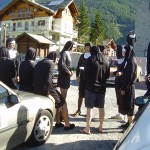 This started with the event that we had been dreading - a group photograph with everyone dressed as nuns. A couple of weeks before the rally I had managed to procure two cut-price nun's costumes from a party shop in Bognor, one medium and one large. When I got home I found that they were described as Adult Female Nun's Costumes, and was going to take them back and change them for Adult Male Nun's Costumes, but then realised that the shop probably wouldn't have any.
This started with the event that we had been dreading - a group photograph with everyone dressed as nuns. A couple of weeks before the rally I had managed to procure two cut-price nun's costumes from a party shop in Bognor, one medium and one large. When I got home I found that they were described as Adult Female Nun's Costumes, and was going to take them back and change them for Adult Male Nun's Costumes, but then realised that the shop probably wouldn't have any.
The meeting place was in a car park adjacent to a motor caravan overnight parking area, the occupants of which seemed somewhat surprised to wake up finding themselves faced with a large number of nuns, most of them rather obviously male. The group photograph was followed by a water pistol fight which Steve and I did not take part in, but I captured on video, dodging about the whole time to keep the camera dry. The challenge for the day was a rather complicated set up, in which team members had to be photographed in nun's costumes in groups including members of the public, the larger the group, the higher the score.
At 10.00am we left, to tackle the nearby Stelvio Pass, which was the most challenging one in the event. The weather had improved at 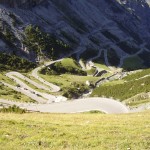 last, but there was more traffic and the climb to the summit was quite slow. There was a break at the summit for a "photo opportunity" and coffee. On the descent the road was clearer, but Steve kept in second gear to spare the brakes, partly I think as an example to me, as he thought I had over-cooked them a bit the day before. As it was around Sunday lunchtime there were a lot of motorcycles and a fair number of hardy souls on bicycles making their way over the pass.
last, but there was more traffic and the climb to the summit was quite slow. There was a break at the summit for a "photo opportunity" and coffee. On the descent the road was clearer, but Steve kept in second gear to spare the brakes, partly I think as an example to me, as he thought I had over-cooked them a bit the day before. As it was around Sunday lunchtime there were a lot of motorcycles and a fair number of hardy souls on bicycles making their way over the pass.
After the Reschen Pass I took over for the comparatively easy drive to Salzburg, mainly on the autobahn. Rather strangely this road runs through Germany for some distance before re-entering Austria. Steve very kindly agreed to allow me to divert a few miles off the route to go up to Oberau, a ski resort that I have visited for over 40 years, but there was no one about at the hotel where my friends and I always stay.
The Hotel Turnerwirt in Salzburg was about 2km from the city centre, but we decided to walk to the evening venue for the exercise. There were quite a lot of Czechwrecks cars around, but it was impossible to tell how many teams had actually arrived. Salzburg seemed very different from how I remembered it from my last visit about 40 years ago, and I can only think there were parts of the city that we did not see on this trip.
Day 4. Monday 30th August. Salzburg to Prague, Czech Republic.
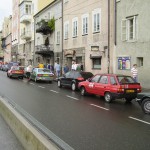 We were given a map the previous evening showing the meeting place, which was described as a disused bus lane alongside the river near the city centre. Shortly after we joined the line of parked cars someone discovered that the bus lane was not disused, and we were quickly handed the challenge sheet and told to go before we got booked.
We were given a map the previous evening showing the meeting place, which was described as a disused bus lane alongside the river near the city centre. Shortly after we joined the line of parked cars someone discovered that the bus lane was not disused, and we were quickly handed the challenge sheet and told to go before we got booked.
This was Old Car Day, and the challenge was to photograph the oldest car we could find, subject to various conditions, the winning team being the one with the photo of the oldest car.
We could choose any route we liked to Prague, and we decided to take the most direct way over ordinary roads via Schäding, because Steve had ridden it previously on motorcycle tours. It was raining yet again and it was on this stretch that we had the most exciting incident of the whole rally.
As we came out of a village Steve glimpsed an old car in the garden of a house and we decided to turn back to look at it. Now, I am not going to say who was driving, but it wasn't me. We travelled rather fast downhill towards a side turning on the left and the driver left the braking a bit too late, so that we turned into the side road with the front wheels locked on loose gravel, sliding relentlessly towards a fence, on the other side of which the ground dropped down into a grassy field. My whole life passed in front of me as I gripped the dashboard with white knuckles, and I breathed a sigh of relief as the car shuddered to a halt a few inches short of the fence.
There is a certain amount of artistic licence in the foregoing description, but it was quite exciting at the time. Upon closer inspection the old car in the garden wasn't old enough to be worth crashing for.
Until now we had used the satnav with great success, but it did not have a program for the Czech Republic. At the Czech border we stopped for a snack, bought a good street map of Prague and I took over the driving. This was my first visit to the Czech Republic and the roads were much better than I had expected, certainly better than some other East European countries.
Our hotel was on the opposite side of Prague to where we came in, and somehow Steve managed to guide us there through heavy traffic on the complicated road system. Without the map it would have been impossible. We decided to go to the evening meeting place at the George and Dragon pub in the city centre by Metro, as it was only 5 stops and we had had enough of the traffic.
When we got there we were surprised how many teams were there, nearly everybody it seemed. Obviously we were not in the running for an award, as we had performed miserably in the challenges, but 2 teams received very well-deserved prizes. One was the Triumph Herald, and the other a small car called Little Eric, driven by a mature couple. It had belonged to a friend named Eric who had died of leukaemia, and was abandoned, flooded, some time before his death. They saved it from being scrapped, got it running and drove it to Prague with sponsorship for a leukaemia charity.
At the start we had not been sure what to expect from the other teams, but we did not see any bad conduct at all. In the initial instructions the organisers had warned very strongly about speeding and reckless driving, and the majority of people stuck to the rules.
In an event like Czechwrecks different teams have very different experiences. Steve and I did not find it very demanding, because we were two people staying in hotels and travelling in a large, fairly powerful and ultimately totally reliable car. Four people in a small, unreliable car having to put tents up every night would be stretched to complete the rally, if they could do so at all. The reliability of the car is the most critical factor and it is a tribute to Steve's thorough preparation that we had no problems.
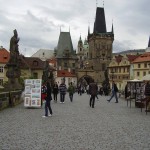 After the rally we stayed for an extra day in Prague, and I have to say that I was extremely impressed with the city. The next morning we visited the excellent Skoda Museum in Mladá Boleslav, about 35 miles away, and in the afternoon we went on a guided tour of the nuclear bunker in Prague, now used mainly as a music venue. As part of the fun we tried on some sticky rubber gas masks that had been worn by several thousand other people, and the next morning I woke up to find a couple of sore spots on my face.
After the rally we stayed for an extra day in Prague, and I have to say that I was extremely impressed with the city. The next morning we visited the excellent Skoda Museum in Mladá Boleslav, about 35 miles away, and in the afternoon we went on a guided tour of the nuclear bunker in Prague, now used mainly as a music venue. As part of the fun we tried on some sticky rubber gas masks that had been worn by several thousand other people, and the next morning I woke up to find a couple of sore spots on my face.
On the way back into Prague from Mladá Boleslav we encountered an extraordinary wall of near stationary lorries on the inside lane of the 3-lane dual carriageway leading into the city, stretching for miles from the city boundary to well past the city centre. It was impossible to see any signs or exits, and we finished up going miles out of way to get back to the hotel.
From Prague we drove straight across Germany and shortly after the border we came up behind a black Audi on the autobahn, and a sign appeared in the rear window BITTE FOLGEN - POLIZEI. They led us into a service area and one of the officers, who were both in very plain clothes, said they were carrying out a check. I decided not to disclose that I could speak German and left Steve, who was driving, to deal with them. One of them asked to see in the boot, pointed to my large silver wheelie case and said "Guns, knives, drugs?". Not surprisingly, Steve said "No" and they did not pursue the matter further. However they took our passports and car documents to their car and it was about ten minutes before one of them gave everything back to Steve and said "You can go now". Steve said the man looked annoyed because they had been unable to find anything wrong.
In Germany we spent a day at the vast Sinsheim Technical Museum and in Belgium called in at the Spa-Francorchamps Motor Racing Circuit museum. On the final day, before catching the ferry, we went to the museums at La Coupole and Le Blockhaus, two proposed German V1 and V2 assembly sites near St.Omer, which fortunately were put out of action by the RAF before they were able to produce any weapons.
When we got back to my house the car was still running perfectly after travelling over 2400 miles, and it has now gone on to the new owner as planned. Before the event some our mutual friends forecast that Steve and I would fall out, which did not happen, but whether we shall do any more rallies like this remains to be seen. CzeckWrecks 2010 was certainly good fun, and at the time of writing a slide show of hundreds of photographs of the event can be found on www.streetsafari.com. Our car is the silver Ford Sierra Sapphire G890 GCL.